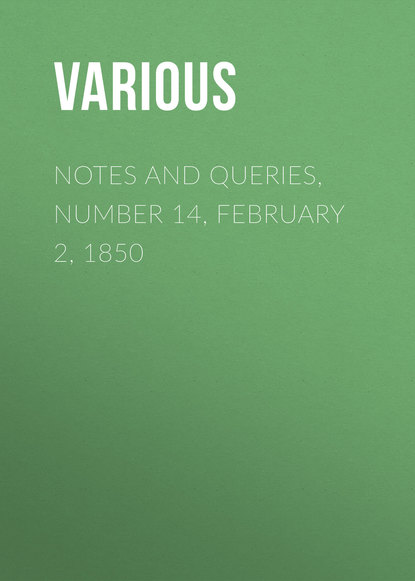По всем вопросам обращайтесь на: info@litportal.ru
(©) 2003-2024.
✖
Notes and Queries, Number 14, February 2, 1850
Автор
Год написания книги
2018
Настройки чтения
Размер шрифта
Высота строк
Поля
I wish to ask a few questions, referring to these lines, if you do not think the subject already exhausted by Mr. Rimbault's curious and interesting communication.
1. Does not the entire quotation run somewhat thus:—
"For he that fights and runs away
May live to fight another day;
But he that is in battle slain
Can never hope to fight again"?
2. Are the two last lines in the Musarum Deliciæ?
3. May not the idea suggesting the two first lines be traced to some passage in one of the orations of Demosthenes, and, PAST him, to the "[Greek: Anaer ho pheugon kai palin machaesetai]" of some contemporary, if not still older writer?
4. Whose Apothegems [qy., those of Demosthenes?] are under consideration on folio 239., from which Mr. Rimbault quotes?
Queries 1, 2, 3 have long stood in MS. in my note-book, and I should much like to see them in print, while the subject to which they refer is still fresh in the minds of your readers.
MELANION
The lines—
"For he that fights and runs away
May live to fight another day,"
resemble the following quatrain in the Satyre Menippée, being one of the several verses appended to the tapestry on which was wrought the battle of Senlis:—
"Souvent celuy qui demeure
Est cause de son meschef;
Celuy qui fuit de bonne heure
Peut combattre de rechef."
A.J.H.
NOTES FROM FLY-LEAVES, No. 5
In the library of St. John's College are some hundreds of volumes bequeathed to it by Thomas Baker; most of these have little notices on the fly-leaves, some thirty or forty of which seem worth printing. One (Strype's Life of Parker) has marginal notes throughout the book, the value of which will be duly appreciated by those who have read Baker's notes on Burnet's Reformation. (See the British Magazine for the last year.)
Hereafter, if you do not object, I hope to send larger extracts from Baker's MSS.; at present I confine myself to a single specimen, taken from the fly-leaf of a copy of Noy's Compleat Lawyer, London, 1665. (St. John's Library, Class mark, I. 10. 49)
"Gul. Noye de S. Buriens. Com. Cornub. Armig. unus Magistrorum de Banco fieri fecit, 1626. On a window in Lincoln Inn's Chapell. See Stow's Survey, &c. vol. ii. lib. ii. p. 73.
"This book has a former edition, London, 1661; but not so fair a print, and without the Author's Life.
"See Fuller's Worthies in Cornwall, p. 200.
"See Mr. Gerard's Letter to Lord Strafford, dated Jan 3. 1634. Mr. Noy continues ill, & is retired to his house at Brentford: I saw him much fallen away in his Face & Body, but as yellow as Gold—with the Jaundice—his bloody waters continue with drain his Body.
"See Lloyd's State Worthies, p. 892, 893. &c.
"Aug. 9. [1634] Wm Noy Esquire the King's Attorney died at Brainford.—Mr. Ric. Smith's Obituary.
"See Wm Noy's Will (very remarkable) MS. vol. xxx. p. 309.
"16th Dec. 1631. Conc. Ornatissimo viro Gulielmo Noye, ut sit de Consilio Universitatis—et annuatim 40th recipiat, &c.—Regr. Acad Cant.
"See Howell's Letters, sect 6. pp. 30, 31.
"Rex 27. October. 1632 constituit Willielmum Noye Arm. Attornatum suum Generalem, durante beneplacito.—Rymer, tom. 19. p. 347.
"See his (W.N.) will, very pious except the last clause, which is next to impious. vol. xxxvi. MS. p. 379.
"Young Noy, the dissipanding Noy, is kill'd in France in a Duell, by a Brother of St. John Biron; so now the younger Brother is Heir and Ward to the King.—A Letter to Lord Deputy Wentworth, vol. ii. p. 2 dat. Apr. 5. 1636."
It may be as well to add, that the references to vols. xxx. and xxxvi. of MS. are to two different copies of the will in two volumes of Baker's MSS., in the University library. The word "dissipanding," in the last quotation, doubtless is an allusion to "dissipanda" in the will itself. I once had occasion to take a copy of this will, and found the variations between the two copies trifling.
J.E.B. MAYOR
[We shall be obliged by our correspondent forwarding, at his convenience, the proposed copies of Baker's MS. notes.]
THE PURSUITS OF LITERATURE
Many years ago, the satirical poem, entitled The Pursuits of Literature, engaged public attention for a very considerable time; the author concealed his name; and from 1796 at least to 1800, the world continued guessing at who could be the author. Amongst the names to which the poem was ascribed were those of Anstey, Colman, Jun., Coombe, Cumberland, Harry Dampier, Goodall, Hudderford, Knapp, MATHIAS, Mansell, Wrangham, Stephen Weston, and many others, chiefly Etonians. George Steevens, it is believed, fixed upon the real author at an early period: at least in the St. James's Chronicle, from Tuesday, May 1. to Thursday, May 3. 1798, we find—
"THE PURSUER OF LITERATURE PURSUED
"Hic niger est.
"With learned jargon and conceit,
With tongue as prompt to lie as
The veriest mountebank and cheat,
Steps forth the black –.
"At first the world was all astounded,
Some said it was Elias;
But when the riddle was expounded,
'Twas little black –.
"This labour'd work would seem the job
Of hundred-handed Gyas;
But proves to issue from the nob
Of little black –.
"Through learned shoals of garbled Greek
We trace his favourite bias,
But when the malice comes to speak,
We recognise –.
"What strutting Bantam, weak but proud,
E'er held his head so high as











